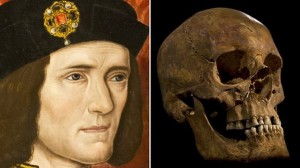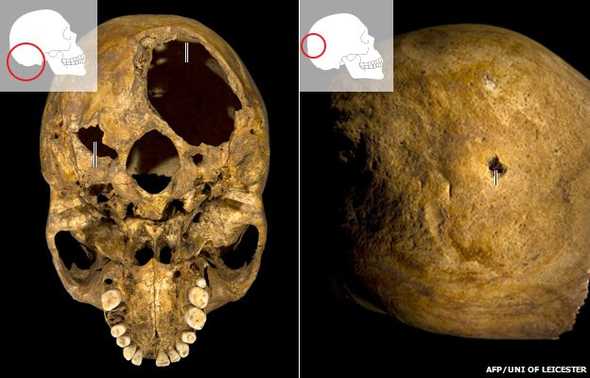The BBC reports on King Richard III:
- Richard was born in 1452 at Fotheringhay Castle in Northamptonshire
- His coronation took place in Westminster Abbey in 1483
- Richard had one of the shortest reigns in British history – 26 months
- He was the last English king to die in battle, killed at Bosworth in 1485
King Richard III was probably killed by two blows to the head during a “sustained attack”, according to new scientific research. Forensic teams studied the skeleton to determine the nature of the injuries and weapons that were used.
The English king was killed at the Battle of Bosworth on 22 August, 1485.
Forensic teams at the University of Leicester have now revealed he suffered at least 11 injuries, some possibly inflicted after death.
CT scans were used on his 500-year-old skeleton to help determine his injuries and the medieval weapons used.
His remains were found under a car park in Leicester in 2012.
The results of forensic analysis, published in The Lancet, show he had nine wounds to the skull and two to the postcranial skeleton.
Researchers said three of these “had the potential to cause death quickly”.
Sarah Hainsworth, study author and professor of materials engineering, said: “Richard’s injuries represent a sustained attack or an attack by several assailants with weapons from the later medieval period.
“Wounds to the skull suggest he was not wearing a helmet, and the absence of defensive wounds on his arms and hands indicate he was still armoured at the time of his death.”
Guy Rutty, from the East Midlands pathology unit, said the two fatal injuries to the skull were likely to have been caused by a sword, a staff weapon such as halberd or bill, or the tip of an edged weapon.
He said: “Richard’s head injuries are consistent with some near-contemporary accounts of the battle, which suggest Richard abandoned his horse after it became stuck in a mire and was killed while fighting his enemies.”
Investigators said they believed damage to the pelvis was caused by a thin dagger stabbed into the buttocks. While this injury could in theory have caused fatal bleeding, it was unlikely to have been the cause of death as Richard’s armour would have protected this part of the body.
They suggested this wound, along with another to a rib, was likely to have been inflicted after death, possibly when the body was slung over a horse.
Researchers said there could have been more wounds to soft tissue which left no trace on the skeleton.
King Richard’s skeleton is due to be reinterred at Leicester Cathedral in March.

